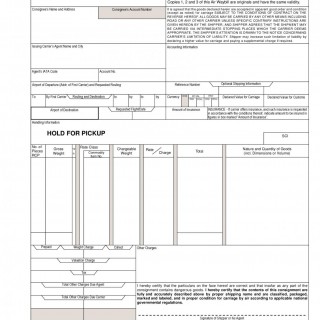Air Waybill
The air waybill is a document which shall be either an air waybill referred to as an “airline air waybill”, with preprinted issuing carrier identification, or an air waybill referred to as a “neutral air waybill” without preprinted identification of the issuing carrier in any form and used by other than an air carrier.
Measurements of the Air Waybill
The outside measurements of the air waybill shall be between 208 mm (8.2 in) and 230 mm (9 in) in width and between 274 mm (10.8 in) and 305 mm (12 in) in length. The size of the boxes and their distances from the upper left hand paper edges shall be maintained exactly as shown in attachment.
Description of the airline Air Waybill set
The airline air waybill set shall be printed as specified below:
- The Original 3 (for Shipper) shall have the same layout, wording and shading as specified in Appendix ‘B’ of attachment;
- The Copy 4 (Delivery Receipt) shall have the same layout, wording and shading as specified in Appendix ‘C’ of attachment;
- The Original 1 (for Issuing Carrier) and Original 2 (for Consignee) shall have the same layout, wording and shading as specified in Appendix ‘D’ of attachment;
- All other copies shall have the same layout, wording and shading as specified in Appendix ‘E’ of attachment;
- The airline air waybill shall be in a set of a minimum of eight copies and shall be marked in the order shown. Colour is optional and airlines shall accept both coloured and non-coloured coded air waybills.
Title Colour
- Original 3 (for Shipper) - Blue
- Copy 8 (for Agent) - White
- Original 1 (for Issuing Carrier) - Green
- Original 2 (for Consignee) - Pink
- Copy 4 (Delivery Receipt) - Yellow
- Copy 5 (Extra Copy) - White
- Copy 6 (Extra Copy) - White
- Copy 7 (Extra Copy) - White
If using colour, copies shall be either coloured paper or white paper with appropriate colour ink imprinted thereon, as referred above.
Additional copies, having the same layout, wording and shading as Appendix ‘E’, may be included in the airline.
Air waybill set to a maximum of five copies. These must be printed on white paper marked “Copy XX (Extra copy for Carrier)”, where XX denotes the number of the copy of the airline air waybill, and may be placed anywhere in the airline air waybill set following Original 1 (for Issuing Carrier);
Notwithstanding the provisions of 3.5 and 3.6, when an air carrier uses an automated system to issue the airline air waybill:
- the airline air waybill shall be executed in a set which includes at least the three original copies,
- further copies of the airline air waybill may be produced by automated means at origin, en route or at destination as required,
- upon interline transfer, at least five copies, of which one copy is entitled “Original 2 (for Consignee)” and one copy is entitled “Copy 4 (Delivery Receipt)”, shall be provided to the onward carrier, upon interline transfer,
When the exchange of a shipment record is not possible, at least five copies, of which one copy is entitled “Original 2 (for Consignee)” and one copy is entitled “Copy 4 (Delivery Receipt)”, shall be provided to the onward carrier,
When the exchange of a shipment record is possible, it is not required that copies of an air waybill be provided to the onward carrier. However the carriers involved must agree to adhere to the provisions of Resolution 600f.
Five key tips
- Make sure to include all the necessary information on the air waybill. This includes the shipper's contact information, the consignee's contact information, the description of the goods being shipped, the weight/volume of the goods, and the estimated value of the goods.
- Use the air waybill to set the terms of the shipment. This includes the expected delivery date, any applicable taxes, any applicable discounts, and any other applicable fees or charges.
- Confirm the air waybill details with the shipper. This includes verifying the accuracy of the information provided, ensuring that all shipment terms are clear, and confirming the expected delivery date.
- Monitor the shipment throughout the transit. This includes tracking the shipment, ensuring that it is arriving on schedule, and making sure that any applicable fees or charges are being paid.
- Keep a copy of the air waybill for your records. This is important for tracking the shipment and making sure that all payments are received in a timely manner.

